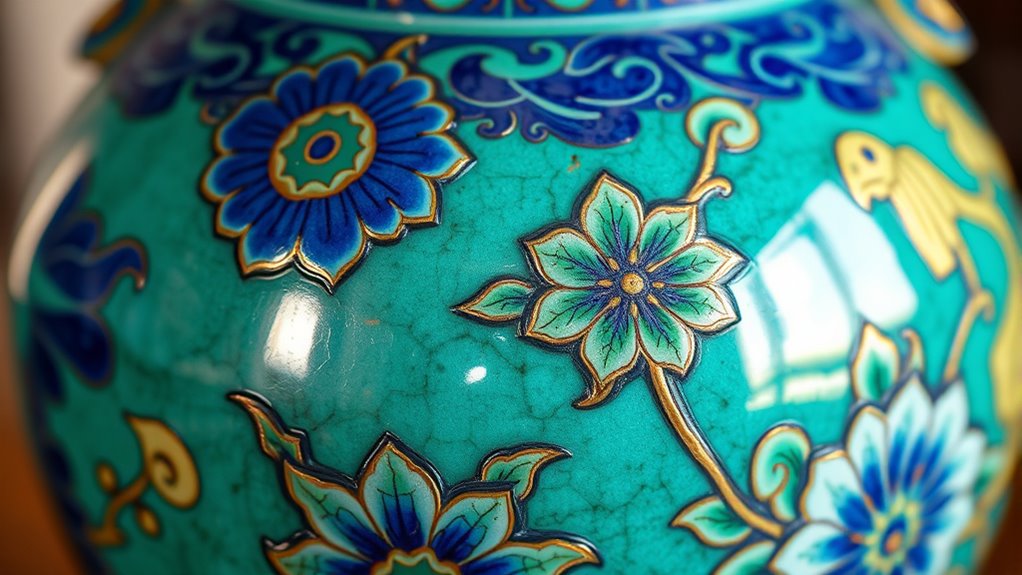The vibrant colors in ancient Chinese ceramics reveal centuries of innovation in glazing and pigment sourcing. Each dynasty perfected specific techniques, from Tang’s bright greens and yellows to Ming’s iconic blue and white using imported cobalt. These hues reflect mastery of mineral extraction, firing conditions, and artistic expression, symbolizing cultural identity and technological skill. By exploring these secrets, you can uncover how craftsmanship and chemistry intertwined to produce enduring beauty—and there’s more to discover if you look further.
Key Takeaways
- Different dynasties mastered unique glazing techniques and pigment sources, producing distinct color palettes like Tang’s vibrant greens and Ming’s blue and white.
- Mineral-based pigments such as cobalt, copper, iron, and manganese were carefully sourced and processed to achieve specific hues.
- Firing conditions, including temperature and kiln atmosphere, critically influenced the final color stability and appearance.
- Glazing not only provided aesthetic appeal but also served as a protective surface, enhancing the durability of the colors.
- The use of color in Chinese ceramics reflects advanced technological skills and cultural symbolism across different historical periods.

Color plays a pivotal role in the allure and cultural significance of ancient Chinese ceramics. When you look at these exquisite pieces, you can’t help but notice the vibrant hues that seem to tell stories of dynasties past. The rich blues, fiery reds, and delicate greens are not just decorative choices—they reflect sophisticated techniques and a deep understanding of materials. At the heart of these colors is the process of ceramic glazing, which forms a shiny, protective surface that enhances the visual appeal. The glaze is more than just a coating; it’s a canvas for the artistry that makes these ceramics so enthralling. Behind the scenes, the choice of pigment sources is vital, as they determine the hue, intensity, and durability of the colors. Ceramic glazing techniques** have evolved over centuries, enabling artisans to achieve a remarkable range of effects and shades. As you explore the history of Chinese ceramics, you’ll find that different dynasties mastered specific glazing techniques and pigment sourcing methods. For instance, during the Tang Dynasty, vibrant green and yellow glazes became prominent, thanks to the use of copper and iron oxides. These materials were carefully sourced and processed to produce consistent, striking colors. The Song Dynasty, on the other hand, favored subtle and refined glazes, such as the famous Ru ware’s icy blue glaze, which relied on particular mineral compositions and firing conditions. The Ming Dynasty’s blue and white porcelain is perhaps the most iconic, utilizing cobalt oxide imported from Persia. Its vivid blue color, set against a white background, became a symbol of Chinese craftsmanship. The process of selecting pigment sources is meticulous. You might be surprised to learn that the pigments come from a variety of mineral and natural sources—cobalt, copper, iron, and manganese, among others. These minerals are ground into fine powders and mixed with glaze materials, creating a palette that artisans could manipulate to produce the desired hues. The firing process, often at high temperatures, interacts with these pigments, transforming them into their final, stable colors. The skill lies not only in choosing the right materials but also in controlling the kiln atmosphere and temperature to achieve consistent results. In essence, the vibrant colors of ancient Chinese ceramics are a tribute to centuries of innovation in ceramic glazing and pigment sourcing. Each piece embodies a blend of artistic vision and scientific precision, resulting in works that continue to enchant and inspire. When you examine these ceramics, you’re witnessing a rich legacy of craftsmanship—one where color is more than decoration; it’s an expression of cultural identity** and technological mastery.
Frequently Asked Questions
How Did Ancient Chinese Artisans Achieve Their Vibrant Glaze Effects?
You can see that ancient Chinese artisans achieved vibrant glaze effects through skillful use of pigment sources and firing techniques. They carefully selected mineral-based pigments, like cobalt and iron, to produce rich colors. During firing, they controlled temperature and atmosphere to develop desired glaze effects, ensuring the pigments fused perfectly. This combination of choosing the right pigments and mastering firing techniques allowed them to create stunning, durable, and colorful ceramics that still amaze today.
What Role Did Trade Routes Play in the Color Palette of Chinese Ceramics?
Imagine a vibrant tapestry woven with threads from distant lands. Trade routes like the Silk Road act as bridges, bringing new colors and ideas into Chinese ceramics. You see the influence of Western trade impacting the palette, introducing richer blues and exotic pigments. These routes expand the artisans’ palette, blending local tradition with foreign inspiration, turning each piece into a colorful dialogue between China and the world.
Were Specific Colors Reserved for Certain Social Classes or Purposes?
You might notice that certain colors in ancient Chinese ceramics symbolized social class or imperial exclusivity. Bright, rare hues like imperial yellow were reserved for the emperor, emphasizing social hierarchy and status. Commoners used more modest colors, reflecting their social standing. This deliberate color use reinforced social class symbolism and highlighted imperial authority, ensuring that specific colors remained exclusive to the upper class or imperial court, preserving their prestige and power.
How Did Technological Advances Influence Ceramic Painting Techniques?
Technological advances transformed ceramic painting by enabling innovative glazing techniques and the development of mineral pigments. You’d notice that artisans adopted new methods to create more vibrant, durable colors, enhancing the beauty of their works. These innovations allowed for intricate designs and richer hues, elevating Chinese ceramics’ artistry. As a result, pottery became more than just functional; it reflected cultural sophistication, showcasing mastery over materials and techniques through technological progress.
Are There Any Symbolic Meanings Associated With Particular Ceramic Colors?
You might think all ceramic colors are just decorative, but they actually carry deep symbolic meanings. In Chinese ceramics, color symbolism plays a key role—red signifies happiness, yellow stands for royalty, and blue often represents immortality. These symbolic meanings reflect cultural values and beliefs, making each hue more than just a visual choice. Recognizing these colors’ significance helps you appreciate the rich storytelling behind ancient Chinese ceramics.
Conclusion
As you explore ancient Chinese ceramics, you realize how their vibrant colors tell stories of dynasties and secret techniques. Imagine holding a Ming dynasty vase, its cobalt blue glaze shimmering under light—each hue revealing centuries of craftsmanship. These colors weren’t just decoration; they were a demonstration to innovation and cultural identity. So, next time you admire a piece, remember the hidden secrets and mastery woven into every shade, making each artifact a timeless masterpiece.









